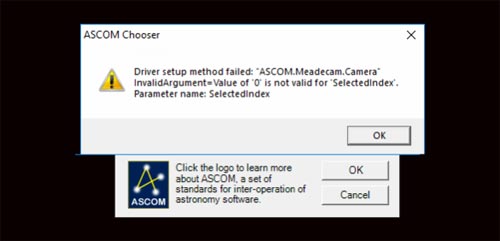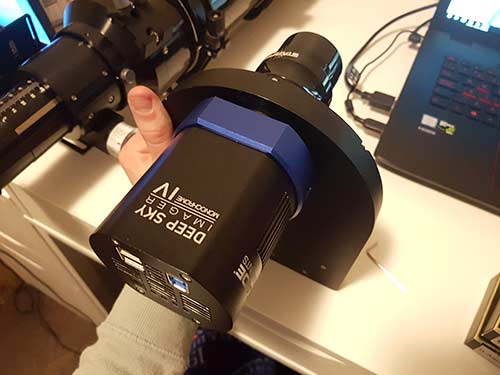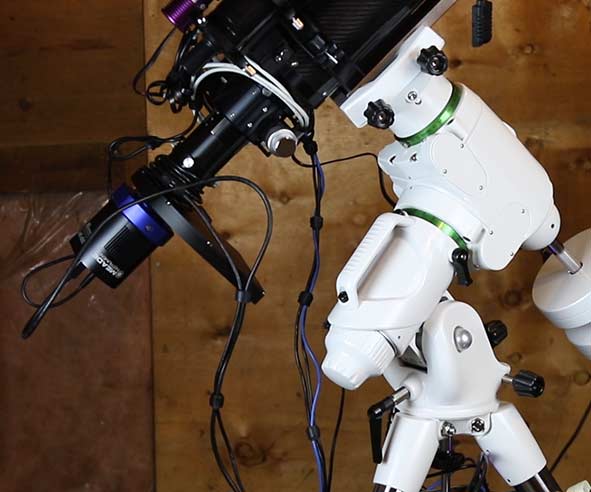Meade Deep Sky Imager IV (Mono)
The Meade Deep Sky Imager (DSI) IV Mono is a dedicated astronomy camera featuring a cooled 16MP CMOS sensor. The thermoelectric cooling, and monochrome Panasonic 4/3” MN34230PLJ image sensor are what I value most in this camera. There is also a one-shot-color version of the DSI IV available, for those that prefer to capture images this way.
A cooled monochrome astronomy camera is an efficient way to collect astrophotography images through LRGB filters to build an impressive color image. The camera cooler ensures that the sensor does not produce added noise by warming up during a long exposure, and a monochrome sensor is better at collecting quality signal (light) than a color camera is.
The Meade Deep Sky Imager IV (Mono)
The mono version of this camera has several competitors using the same chip. The reason I have chosen to go with the Meade variation is simply because I was given an opportunity to test it and share information about it. This camera was generously loaned to me from Ontario Telescopes.
You can see the Meade DSI IV mono as the primary imaging camera on a complete deep sky astrophotography rig in this video:
In the video above, you’ll see that I’ve got the Meade DSI IV mono connected to a 5-position electronic filter wheel to capture images in LRGB through an Explore Scientific ED 102 telescope. Everything is balanced perfectly from the weight of the imaging payload, to the accessories riding along on top of the telescope.
Related Post: Astrophotography Gear Update (2019)
Meade DSI IV Mono
The sleek design and impressive weather resistant carrying case are the first things I noticed with the Meade DSI IV. Although Meade lists the inclusion of the SkyCapture software as an added value, I believe many future owners of the Deep Sky Imager will prefer to use their own astrophotography software with this camera.
Meade also draws attention to the fact that this astronomy camera has a fast USB 3.0 readout, which is important for planetary imaging. I have a feeling the Meade DSI IV mono will be used more for long exposure astrophotography, thanks to its low read noise properties. When it comes to high quality astrophotography images, noise is the enemy.
Cooled cameras like this still blow me away in terms of how little noise they produce even when exposing the shutter for 5-minutes at a time in the summer heat. Those coming from a background in DSLR astrophotography like myself will likely experience this eye-opening moment as I did the first time I used a cooled camera.
16MP Panasonic 4/3 Sensor
The Panasonic MN34230PLJ CMOS sensor is a very popular chip for dedicated astronomy cameras. As you’ll see in the table below, this CMOS sensor is found inside of astronomy cameras from several brands.
| Brand | Camera |
|---|---|
| Meade | DSI IV Mono |
| ZWO | ASI1600MM Mono |
| QHY | 163M |
| ATIK | Horizon |
| Mallincam | SkyRaider DS16C |
The Deep Sky Imager series of cameras from Meade has been around for a long time. As a matter of fact, I still own a Meade DSI Pro II camera that I purchased back in 2012. I used this camera for autoguiding exclusively, and it worked well for many years until I finally upgraded to an Altair GPCAM2.
The Meade DSI Pro IV houses the same sensor found on the ZWO ASI1600MM (Panasonic MN34230PLJ CMOS). This camera has built up quite the reputation over the past years, and some of my favorite amateur astrophotographers use this camera. I anticipate the Meade DSI IV mono to keep pace with the image quality of the 1600.
A lot of amateur astrophotographers that have been in the game for a while have fond memories of using Meade cameras many years ago. There was a large gap between the release of the Meade DSI III and the IV. Here is an interesting discussions about this timing from the Cloudy Nights forum.
After unboxing the Deep Sky Imager IV monochrome camera in my frigid garage, I placed each item on the table to get a good look at what’s included in the package from Meade:
What’s Included:
- DSI IV Camera
- 2″ Nosepiece
- AC Power Adapter (US plug only)
- USB 3.0 cable
- Desiccant plug
- Software CD
- Hard carrying case
Meade Deep Sky Imager IV – First Impressions
The camera is very impressive in terms of design and build quality. I like that Meade decided to include a robust hard carrying case with this camera, which I will put to good use when traveling to darker skies with this camera.
The software for the camera was provided on a CD, which felt a little “old-school” to me. My imaging laptop is very compact, and does not include a CD drawer. This means that I had to pull the the camera drivers and SkyCapture software off of the CD and on to another machine first.
The necessary drivers needed to run the camera using third party software such as Astro Photography Tool (APT) are on the CD only. The software downloads are not available from the product page as stated in the user guide.
Instead, navigate to the downloads page of the support section. There you will find what you need inside of the SkyCapture software download folder.
Connecting to Third Party Camera Control Software
When I first attempted to use the Meade DSI IV camera, I was delivered an error in connection from Astro Photography Tool when clicking the “properties” tab.
The problem was that I needed to copy the ASCOM Meade driver (only found on the CDROM) over to my imaging laptop and install. This driver is not available online from the Meade website.
Having already installed the Meade drivers found on their website, my assumption was that I needed to also install the DirectShow drivers mentioned in the user guide, but not available online.
The error code I received when clicking the properties tab in the ASCOM chooser
This was indeed the issue, and solved the problem. So if you are in a similar situation, make sure you install the DirectShowDriver that is included on the included CDROM. So aside from the standard ASCOM drivers, make sure you install all of the files from the CD.
SkyCapture Software
I did try out the Meade SkyCapture v2.1 software, and was not overly impressed. The user interface feels dated, and in my experience, the left-hand menu bar did not load properly. The “trigger mode” section was inaccessible.
I did investigate a few areas of this application including the default image format captured (.png) and the location of where the files are stored. If you choose to use the SkyCapture software to run your Meade DSI IV mono, be sure to change the image format to FITS.
With the Meade ASCOM driver installed, I was finally able to adjust the settings of this camera in Astro Photography Tool including frame rate, gain and black level. To test the cameras cooling function, I told the camera to reach -25 degees C, 2 degrees at a time.
The camera cooled very quickly, faster than the ASI294MC Pro. Once the camera hit my intended target of -25 C, I took some dark frames that I can apply to a future imaging session.
Meade DSI IV Mono Specs:
- Camera Sensor: Panasonic MN34230PLJ CMOS
- Sensor Size: 4/3″ format, 16 Megapixels (4640 x 3506)
- Pixel Size: 3.8μm x 3.8μm
- Cooling: Two-Stage TEC, 40 – 45C below ambient
- ASCOM Compatible: Yes
- Interface Type: USB 2.0 or 3.0
- Back Focus Distance: 17.5mm
- Image Formats: JPEG, BITMAP, FITS
Back Focus Distance
The back focus distance on the Meade DSI IV is 17.5mm, which means that this is how much space is between the camera sensor, and the edge of the camera. You can use this measurement to calculate the correct spacing when you have the camera connected to a field flattener/reducer, and your telescope.
I have the Meade DSI IV threaded to my filter wheel using an M54 t-mount adapter, and then a 0.8X Starfield reducer/flattener sits on the other end to connect to the telescope. The mono camera sensor can now capture images through each filter (red, green, blue, and luminance), and can be controlled using software on my PC (APT).
Connecting to a Filter Wheel
As I mentioned, I have the Meade DSI VI mono connected to a Xagyl 5-position filter wheel. This allows me to easily change the 2-inch Optolong LRGB filters that sit in front of the camera without touching my telescope. The wheel is connected to my PC using a mini USB cable, and controlled using the ASCOM filter wheel controls found in the gear tab of APT.
To fasten the camera to the filter wheel, I used the Xagyl M54 t-mount adapter to thread it on to the opening on to the 2-inch opening on the wheel. The spacing was important here, as the field flattener/reducer I use requires 55mm of spacing between the camera sensor, and the back of the flattener for optimal imaging performance.
Attaching a 5-position filter wheel to the Meade DSI IV
You can control a filter wheel like this in most astrophotography software applications, such as Astro Photography Tool or Sequence Generator Pro. The filter can be selected ahead of time and scheduled into a sequence of image captures through each one.
One of the main reasons I chose to use this camera and filter wheel with my Explore Scientific ED 102, is because this telescope includes a motorized focuser. I added a Pegasus Astro stepper motor kit and dual motor focus controller (DMFC) early last year, and it allows me to quickly re-focus between filters remotely.
Here is a breakdown of the astrophotography rig I am using with the Meade Deep Sky Imager IV Mono:
- Mount: Sky-Watcher EQ6-R Pro
- Telescope: Explore Scientific ED102 CF Refractor
- Camera: Meade DSI IV Mono
- Filter Wheel: Xagyl 5-Position 2″ Wheel
- Filters: Optolong LRGB filter set (2″)
- Guide Scope: Starfield 50mm Guide Scope
- Guide Camera: Altair GPCAM2
- Focuser: Pegasus Astro Stepper Motor Kit w/ DFMC
- Power: Pegasus Astro Pocket Power Box
- Camera Control: APT via Laptop Computer
The camera and filter wheel attached to my telescope in the garage.
Final Thoughts
The real test of the Meade DSI IV will happen when I actually start collecting some deep sky images with this camera from my backyard. As the images roll in, I will share my results on this page and on my social media profiles.
I could not find a single image taken with the Meade Deep Sky Imager IV on Astrobin yet, so I feel like the images I share may be placed under the microscope, at least until more images start to roll in.
The plan is to capture enough data through each LRGB filter to create a full color deep sky image. With a limited clear sky time window and the Orion constellation quickly fading into the western sky each night, I may choose to photograph M42 for the 300th time to test this camera. I can HEAR your eyes rolling from here.






